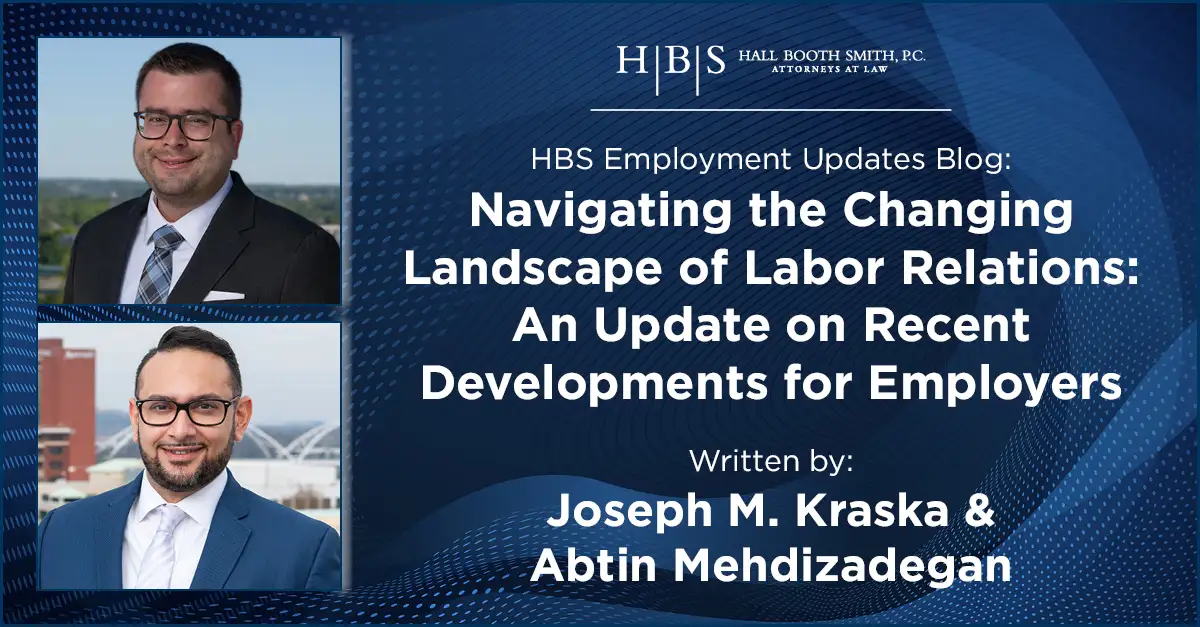
Navigating the Changing Landscape of Labor Relations: An Update on Recent Developments for Employers
In a world where the only constant is change, the realm of labor relations and employment law is no exception. The landscape is continually reshaped by new regulations, technological advancements, and shifting societal norms. For employers navigating these turbulent waters, staying informed and agile is not just advantageous, it’s essential.
This article delves into three pivotal developments in the field: the Executive Order on Artificial Intelligence, the National Labor Relations Board’s (NLRB) new Joint Employer Rule, and the collaborative efforts of the Occupational Health and Safety Administration (OSHA) and NLRB. This article explores the nuances of these changes and offers practical guidance for employers to remain compliant and ahead of the curve.
Executive Order on Artificial Intelligence
The Biden Administration’s comprehensive executive order, issued on October 30, 2023, marks a significant milestone in the integration of Artificial Intelligence (AI) in the workplace. This order, titled “Executive Order on the Safe, Secure, and Trustworthy Development and Use of Artificial Intelligence,” brings a fresh perspective to AI enforcement, worker protections, and federal contractors’ use of AI in the workplace. A key focus of this order is the regulation of employer monitoring in both unionized and non-unionized settings, presenting new challenges and opportunities for employers.
The Impact of the Executive Order on Worker Surveillance
The Executive Order instructs the Secretary of Labor to develop and publish principles and best practices for employers concerning AI’s impact on labor standards, job quality, equity, protected activities, compensation, health, and safety in the workplace. The Executive Order also instructs that these principles and best practices are to be developed in consultation with outside entities including labor unions and workers. It also addresses the collection and use of data about employees in relation to transparency, engagement, and activities protected under worker-protection laws. Furthermore, the order emphasizes the need for employers deploying AI to monitor or augment employees’ work to continue complying with fair compensation and other legal requirements.
This order grants the Department of Labor significant authority to regulate the use of AI in employee monitoring, which poses potential liability risks for both unionized and non-unionized employers. It introduces a vague, blanket authority for regulating AI concerning “activity protected under worker-protection law,” indicating a potential focus on the intersection of AI and protected concerted activity under the National Labor Relations Act (NLRA) and Title VII of the Civil Rights Act of 1964. The NLRB General Counsel has already shown interest in regulating employers using AI or algorithm-based software to monitor employees in a memo she issued on October 31, 2022. Likewise, the Equal Employment Opportunity Commission (EEOC) has issued guidance concerning the adverse impact of AI in making employment decisions.
With the Executive Order expanding the scope of activities subject to regulation, employers should expect an increase in AI-related regulation by federal agencies in the near future, including the NLRB’s and the EEOC’s attempt to address monitoring of employees with AI. To mitigate potential liability, employers should consider the following recommendations.
Recommendations for Employers
Employers can expect the Department of Labor to issue its AI guidance sometime in the spring of 2024. In the meantime, employers should conduct a review of their AI monitoring practices to ensure they are in compliance with the evolving guidance. This includes an assessment of how AI is used in monitoring employees, data collection, and if it is used to make employment related decisions.
The NLRB Issues New Joint Employer Rule
On October 26, 2023, the NLRB issued a final rule that significantly broadens the definition of “joint employment” under the NLRA. The NLRB’s final rule represents a paradigm shift in defining “joint employment” under the NLRA. Moving away from the narrower “direct and immediate control” criterion, this new rule adopts a more inclusive approach, considering joint employment even in scenarios where control is merely possessed or reserved. This development not only broadens the potential for joint employer status but also underscores the need for employers to critically examine their relationships with third parties such as subcontractors and franchisees.
This new rule makes it easier for the NLRB to find that two entities are joint employers, subjecting them to collective bargaining and potential liability for unfair labor practices. Unlike the previous rule, which required “direct and immediate control” by the potential joint employer, the new rule considers joint employment if an entity possesses or reserves the right to exercise control, regardless of whether it ever actually exercised.
The Evolution of the Joint Employer Doctrine
The NLRB’s stance on joint employer status has undergone significant changes over the past decade. The 2015 Browning-Ferris decision expanded the scope of joint employment under the NLRA, allowing companies to be liable as joint employers based on the existence of reserved joint control or indirect control. In 2018, a U.S. Court of Appeals ruling upheld parts of Browning-Ferris but found that the concept of indirect control had been applied too broadly. This contributed to the 2020 rule, which required “substantial direct and immediate control” over terms and conditions of employment.
The New Joint Employer Rule
The new rule builds upon Browning-Ferris, resulting in the broadest definition of joint employment to date. It considers an entity a joint employer if it shares or co-determines employees’ essential terms and conditions of employment. This rule includes seven “essential” terms and conditions, and if an entity has the authority to control at least one of these terms, the NLRB will find joint employer status. The essential terms and conditions include:
- Wages, benefits, and other compensation;
- Hours of work and scheduling;
- The assignment of duties to be performed;
- The supervision of the performance of duties;
- Work rules and directions governing the manner, means, and methods of the performance of duties and the grounds for discipline;
- The tenure of employment, including hiring and discharge; and
- Working conditions related to the safety and health of employees.
The rule is set to take effect on December 26, 2023, and there have been multiple challenges to the NLRB’s rule making authority filed by both management and union side coalitions. Additionally, a group of Congressional lawmakers have introduced a resolution to overturn the Board’s rule, which if passed would undoubtedly face a veto. Although these efforts may delay the rule’s effective date, they will not prevent the Board from reviving the standard through its adjudication powers.
Recommendations for Employers
Employers should review their contracts with third parties, such as subcontractors, staffing agencies, or franchisees, to identify areas where they might relinquish control over their workforce. It is crucial for employers to understand the potential implications of joint employer status and to take steps to minimize risks. Once employers have reviewed and evaluated their contracts and business practices, they should continue to monitor their relationships and make necessary adjustments to minimize the risk of being deemed a joint employer. Finally, employers should also ensure that management teams are well-versed in the new joint employer rule and its implications. Educating management on compliance measures and best practices is key to managing risk and avoiding liability.
The NLRB-OSHA Memorandum of Understanding
On October 31, 2023, the NLRB and OSHA announced a Memorandum of Understanding (MOU) to strengthen their partnership in promoting safe and healthy workplaces while protecting workers who report unsafe conditions. This MOU involves information sharing, cross-training, and collaborative investigative efforts. The MOU’s purpose is to protect workers who speak out about unsafe working conditions without fearing retaliation. It is part of the Biden Administration’s interagency coordination initiative, pushing for increased collaboration between federal agencies to ensure comprehensive protection for workers, and in turn, comprehensive, concerted enforcement action against employers.
Preparing for Joint OSHA-NLRB Enforcement
The MOU opens the possibility of joint inspections by OSHA and the NLRB, but that’s not all. The MOU also states that if an employee files an untimely complaint with OSHA, OSHA will expressly advice the employee making the complaint that they can file an Unfair Labor Practice (ULP) charge with the NLRB and recommend the employee do so “as soon as possible.” OSHA will provide the employee with the phone number and link to the NLRB’s website where the employee can file a ULP. The MOU also establishes reciprocal training for appropriate staff in both agencies. This means NLRB Board agents and field examiners will be training on OSHA regulations such as record-keeping and reporting regulations as well as whistleblower protection and the general duty clause. OSHA compliance officers and investigators will likewise receive training on what is considered protected concerted activity and what is considered a ULP under the NLRA.
Recommendations for Employers
Employers need to be extra cautious when submitting a response or interacting with agency officials of OSHA or the NLRB. Information submitted to OSHA regarding employee complaints or discipline could lead to ULP charges being filed with the NLRB. Employers also need to establish protocols for addressing OSHA and NLRB inspections, including who should be available and what procedures to follow during such an inspection. Finally, employers need to educate management on anti-retaliation provisions contained in the OSH Act and NLRA.
Conclusion
The landscape of labor relations and employment law is continuously evolving, and staying ahead requires a proactive and informed approach. Employers are encouraged to review their practices in light of these developments and seek expert guidance to navigate these changes effectively. For further insights and assistance, please contact Joseph Kraska, Abtin Mehdizadegan, or any member of Hall Booth Smith’s Labor & Employment practice group for advice.
Disclaimer
This material is provided for informational purposes only. It is not intended to constitute legal advice nor does it create a client-lawyer relationship between Hall Booth Smith, P.C. and any recipient. Recipients should consult with counsel before taking any actions based on the information contained within this material. This material may be considered attorney advertising in some jurisdictions. Prior results do not guarantee a similar outcome.
Blog Overview
About the Authors
Little Rock Associate Joseph M. Kraska specializes in management side labor and employment matters. He has represented clients in collective bargaining, RC petitions, unfair labor practices charges, labor arbitration, OSHA compliance matters, and federal and state employment discrimination matters, and he provides general employment advice.
Little Rock Partner Abtin Mehdizadegan specializes in management side labor and employment law matters. He has extensive, high-stakes experience defending businesses in class and collective action lawsuits, employment and wage and hour lawsuits, labor grievance and arbitration proceedings, individual and systemic proceedings before the Equal Employment Opportunity Commission (EEOC), unfair labor practice charges before the National Labor Relations Board (NLRB), federal wage and hour audits involving the Department of Labor’s Wage and Hour Division (DOL/WHD), unemployment appeals, business disputes, products liability defense, and constitutional law litigation.





Leave a comment
You must be logged in to post a comment.